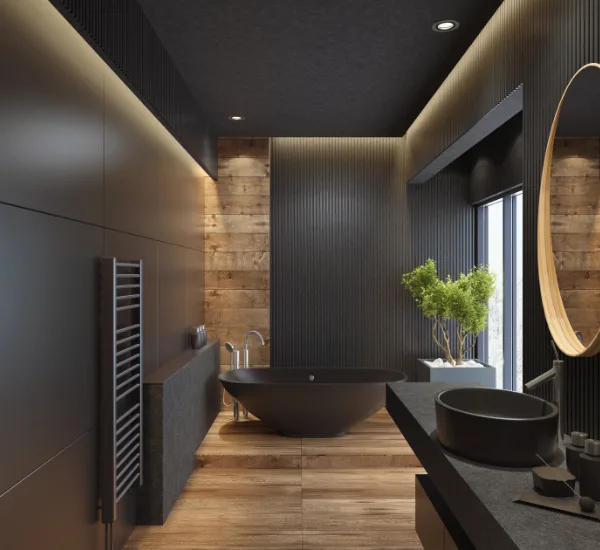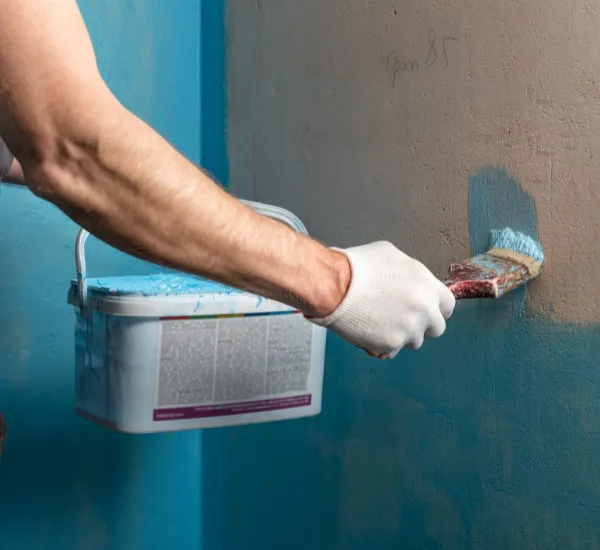When planning a bathroom makeover, one question often pops up: can you use flat paint in the bathroom? Bathrooms face unique challenges — high humidity, frequent temperature changes, and constant moisture exposure.
Choosing the right paint finish isn’t just about aesthetics; it’s crucial for keeping your space looking fresh and preventing future problems like peeling or mildew. In this comprehensive guide, we’ll explore whether flat paint can work in bathrooms, when it might be appropriate, and better alternatives you should consider for a beautiful, durable finish.

Why Paint Finish Matters in Bathrooms
Bathrooms are wet, humid environments by nature. Steam from showers and baths creates a perfect setting for mold, mildew, and peeling paint if you don’t use the right type of coating. Before diving into specific recommendations, let’s understand what makes bathrooms different from other rooms in your home and why paint selection is so important.
Understanding Paint Finishes
Different paint finishes have varying levels of durability, moisture resistance, and appearance:
- Flat/Matte Paint: Contains the highest pigment concentration and lowest amount of binders and resins, resulting in no shine and excellent coverage. It absorbs light rather than reflecting it.
- Eggshell Paint: Has a slight sheen (like an eggshell) and offers better moisture resistance than flat paint.
- Satin Paint: Provides a gentle luster with good durability and moisture resistance.
- Semi-Gloss Paint: Has a visible shine and excellent moisture resistance, making it easy to clean.
- High-Gloss Paint: Offers the most reflective, shiny surface with maximum durability and moisture resistance.
The higher the gloss level, the more durable and moisture-resistant the paint typically is—making glossier finishes traditionally preferred for bathrooms.
Characteristics of Flat Paint
Flat paint is known for its:
- Low sheen (non-glossy, velvety appearance)
- Excellent ability to hide surface imperfections
- Light absorption rather than reflection
- Traditionally less durability and cleanability
- Tendency to absorb moisture
Because of these traits, flat paint is typically not recommended for high-moisture rooms like bathrooms, unless specific moisture-resistant formulas are used.
Can You Use Flat Paint in the Bathroom?
The Short Answer
It’s not ideal. While you technically can use flat paint in a bathroom, standard flat paint is not designed to withstand the moisture and humidity commonly found in these spaces.
Flat paint is beautiful for low-traffic, dry areas — think bedrooms or formal living rooms. However, in a bathroom, it can absorb moisture, leading to:
- Water stains
- Peeling and flaking
- Mold and mildew growth
- Difficult cleaning
- Shorter lifespan
If you still love the look of a matte finish, look for specially formulated moisture-resistant flat or matte paints. Several paint brands offer bathroom-specific flat paints that resist moisture and mildew while maintaining that elegant, low-sheen look.
✅ Pro Tip: If you opt for flat paint in the bathroom, make sure your space is well-ventilated with a high-quality exhaust fan that runs during and after showers.
Pros and Cons of Using Flat Paint in Bathrooms
Advantages of Flat Paint
- Superior Coverage: Flat paint excels at hiding wall imperfections and provides the most even color coverage.
- Rich, Sophisticated Appearance: Creates a deep, velvety look that many designers prefer for its elegant aesthetic.
- Non-Reflective Surface: Doesn’t create glare or highlight surface irregularities the way glossier finishes do.
- Easy Touch-Ups: Blends seamlessly when touching up small areas, unlike glossier finishes where patches may be noticeable.
Disadvantages of Flat Paint
- Poor Moisture Resistance: Standard flat paint is porous and can absorb moisture, potentially leading to mold and mildew growth.
- Difficult to Clean: The porous texture traps dirt and doesn’t stand up well to scrubbing or frequent cleaning.
- Less Durable: More prone to damage, scuffing, and marking than higher-gloss alternatives.
- Shorter Lifespan: May need to be repainted more frequently in high-moisture environments.
Where Can You Use Flat Paint in the Bathroom?
Bathroom Walls
Can you use flat paint on bathroom walls? You can technically use flat paint on bathroom walls, but it must be a moisture-resistant, mildew-resistant flat paint designed specifically for high-humidity areas. Otherwise, traditional flat paints will not hold up well in a bathroom environment.
👉 Best practice: Choose a satin or semi-gloss finish for walls to balance durability and appearance, especially in full bathrooms with showers or tubs.
Flat paint might work better in:
- Low-traffic guest bathrooms or powder rooms
- Homes in dry climates
- Bathrooms with excellent ventilation systems
Bathroom Tiles
Can you use flat paint on bathroom tiles? No, flat paint is not suitable for tiles — bathroom tiles are often exposed to direct water (especially in showers and around tubs).
For tiles, you need:
- Tile-specific epoxy paint or waterproof enamel paint
- Special primers designed for tile adhesion
- Multiple protective top coats
Flat paint will not adhere properly to tiles and will quickly peel when exposed to water, regardless of the formulation.
Bathroom Ceilings
Can you use flat paint on bathroom ceilings? Yes, bathroom ceilings are one area where flat paint can work well.
Ceilings typically don’t face direct water exposure but still endure a lot of humidity. Flat paint is often preferred for ceilings because:
- It hides imperfections better than glossy finishes
- Doesn’t create glare under lighting
- Creates a visual sense of height and spaciousness
However, use a mildew-resistant flat ceiling paint designed specifically for bathrooms. If you can’t find a moisture-resistant flat, a matte finish with added mold protection would be a smart alternative.
What Type of Paint Is Best for Bathrooms?
If you’re asking, “what type of paint is best for bathrooms?” the safest choices are:
1. Satin Finish
- Slight, subtle sheen
- Good moisture resistance
- Easy to wipe clean
- Popular for bathroom walls
- Balances durability with attractive appearance
2. Semi-Gloss Finish
- Higher, noticeable sheen
- Excellent moisture resistance
- Very easy to clean
- Best for trim, doors, and sometimes walls
- Most durable for high-moisture areas
3. Eggshell Finish
- Low sheen but more durable than flat
- Modest moisture resistance
- A good compromise for those wanting a softer look
- Works well in powder rooms or guest bathrooms
4. Special Moisture-Resistant Paints
Many brands now offer bathroom-specific paints labeled as “mildew-resistant,” “bathroom paint,” or “kitchen and bath.” These are excellent choices regardless of the sheen level you prefer.
Is Flat Paint Moisture Resistant?
No, traditional flat paint is not moisture-resistant.
Flat finishes are porous, meaning they easily absorb moisture. This makes them more prone to:
- Mold growth
- Mildew development
- Water staining
- Peeling and flaking
Moisture-resistant versions of flat paints do exist, but you’ll need to specifically choose one marketed for bathroom or kitchen use. These specialized formulations contain additives that help resist moisture absorption and mildew growth while maintaining the flat aesthetic.
Best Moisture-Resistant Paints for Bathrooms
Here are some top-rated moisture-resistant paints perfect for bathrooms:
| Brand | Product | Finish Options | Key Features |
|---|---|---|---|
| Benjamin Moore | Aura® Bath & Spa | Matte | Mildew resistant, durable, washable |
| Sherwin-Williams | Duration Home® | Satin, Semi-gloss | Mildew resistant, easy to clean |
| Behr | Premium Plus Ultra® | Satin, Semi-gloss | Stain-blocking, mildew resistant |
| Zinsser | Perma-White® | Satin, Semi-gloss | Mold & mildew-proof guarantee |

Best Practices for Bathroom Paint Projects
Proper Preparation
Whatever finish you choose, proper preparation is essential:
- Address Moisture Issues First: Fix any leaks, improve ventilation, and address humidity problems before painting.
- Thorough Cleaning: Remove all soap scum, mildew, and grime from surfaces.
- Quality Primer: Use a mold/mildew-resistant primer specifically formulated for bathrooms.
- Surface Preparation: Sand, patch, and smooth walls before painting for the best results.
Application Tips
- Multiple Thin Coats: Apply several thin coats rather than one thick coat for better durability.
- Proper Drying Time: Allow extended drying time between coats in bathroom environments.
- Ventilation During Application: Ensure excellent ventilation during and after painting.
- Use Quality Tools: Quality brushes and rollers ensure a smooth, even application.
Maintenance Considerations
To keep your bathroom paint looking fresh:
- Regular Inspection: Check frequently for signs of moisture damage or mildew.
- Enhanced Ventilation: Use exhaust fans during and after showers.
- Gentle Cleaning: Clean with non-abrasive products to prevent damage.
- Regular Maintenance: Clean your bathroom walls and ceilings periodically to prevent buildup of mold.
- Be Prepared to Repaint: Plan for more frequent repainting if you chose flat paint.
FAQs About Bathroom Paint
Can I use flat paint for a bathroom?
You can use flat paint in a bathroom, but only if it’s a specially formulated moisture-resistant flat paint designed for high-humidity environments. Standard flat paint is not recommended as it’s prone to moisture damage, mildew growth, and is difficult to clean. For most bathrooms, satin or semi-gloss finishes are better choices.
What type of paint is best for bathrooms?
For most bathrooms, semi-gloss or satin finishes are considered the best options due to their moisture resistance, durability, and cleanability. Eggshell can work well in low-moisture bathrooms, while specialized bathroom paints in various sheens offer enhanced protection regardless of finish.
What type of paint is best for bathroom ceilings?
Flat or matte paint specifically formulated for high-humidity environments is ideal for bathroom ceilings. These specialized ceiling paints resist moisture and mildew while providing the aesthetic benefits of a flat finish, which helps hide imperfections and creates a sense of height.
Is flat paint moisture resistant?
No, standard flat paint is not moisture resistant. It has a porous surface that can absorb moisture and is more susceptible to water damage, mildew, and staining. However, some manufacturers now offer specialized moisture-resistant flat paints specifically formulated for bathrooms and other high-humidity areas.
Can you use regular interior paint in a bathroom?
While you can use regular interior paint in a bathroom, it’s not recommended, especially for shower areas or bathrooms with high moisture levels. Bathroom-specific paints contain additives that resist mildew, moisture, and frequent cleaning, making them worth the additional cost for longevity and performance.
Final Words: Making the Right Choice for Your Bathroom
So, can you use flat paint in the bathroom? Technically yes — but only if it’s a special moisture-resistant flat paint. Otherwise, satin, semi-gloss, or eggshell finishes are much safer choices for a long-lasting, beautiful bathroom.
When deciding on the right paint for your bathroom, consider your specific situation:
- For primary bathrooms with showers/tubs: Choose satin, semi-gloss, or specialized bathroom paint in your preferred sheen.
- For powder rooms or guest bathrooms: Eggshell or specialized flat bathroom paint can work well.
- For bathroom ceilings: Moisture-resistant flat paint is often the best choice.
Remember that proper preparation, quality products, and good ventilation are just as important as the paint finish you select. By weighing the aesthetic appeal of flat paint against the practical needs of your bathroom environment, you can make an informed decision that results in a beautiful, durable finish.
Choosing the right paint protects your bathroom investment and keeps it looking its best for years to come. Whenever possible, prioritize durability and moisture resistance over aesthetic alone — and you’ll thank yourself later!
Suggested Visuals
- Infographic: “Best Paint Finishes for Bathroom Surfaces”
- Step-by-Step Chart: “How to Prepare a Bathroom for Painting”
- Side-by-Side Comparison: “Flat Paint vs Satin Paint in Bathrooms”
- Chart: “Humidity Levels and Recommended Paint Finishes”


